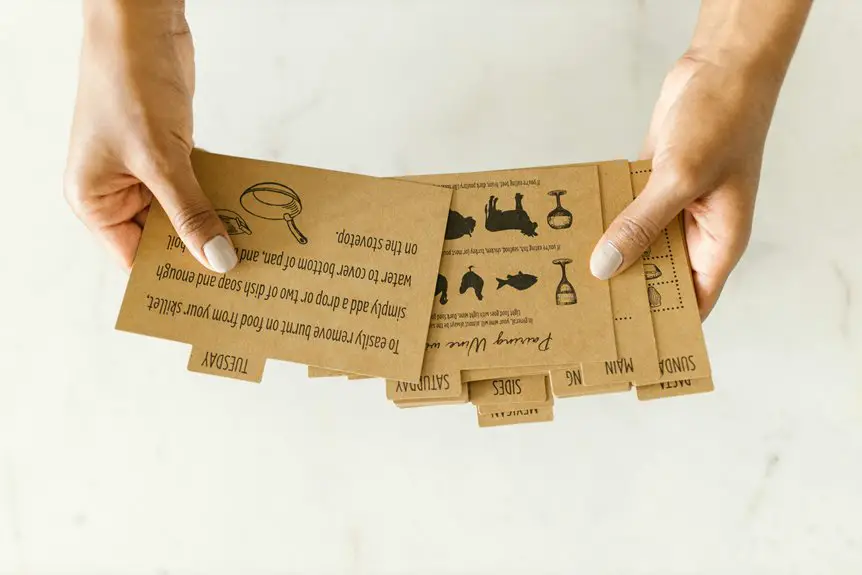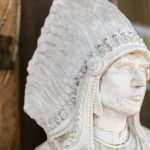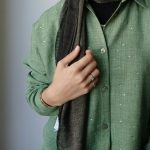If you’re new to Guatemalan ikat textiles, know they’re made by dyeing yarns before weaving, creating beautiful blurred patterns with vibrant colors. These textiles carry deep cultural meaning, with each motif symbolizing traditions or status in indigenous communities. The process involves careful tying and dyeing of threads, preserving centuries-old craftsmanship. You’ll find these textiles more than just fabric—they’re expressions of identity and heritage. Exploring further reveals their rich history and symbolic designs.
Table of Contents
Key Takeaways
- Guatemalan ikat is a resist-dyeing textile technique where threads are dyed before weaving to create blurred, intricate patterns.
- The weaving method, called “jaspe,” uses multiple dye baths and yarn tying to produce vibrant, organic designs.
- Ikat patterns often feature geometric shapes and natural motifs symbolizing fertility, protection, and cultural stories.
- Traditionally woven on backstrap looms, these textiles reflect deep indigenous cultural identity and communal craftsmanship.
- Ikat textiles signify social status, village origins, and life events, serving important cultural and ceremonial roles.
What Is Ikat and How Is It Different?
Ikat is a unique textile technique where the threads are dyed before weaving, creating intricate patterns with a characteristic blurred effect.
When you look closely, you’ll notice that the colors aren’t perfectly sharp like in printed fabrics; instead, they’ve a soft, feathered edge. This happens because the threads are tightly bound and dyed in sections before weaving, which requires careful planning and skill.
Unlike other textiles where patterns are added after weaving or knitting, ikat’s design is embedded in the threads themselves. You’ll find that no two ikat pieces are exactly alike due to slight shifts during dyeing and weaving.
This distinct process gives ikat its vibrant, organic feel that sets it apart from other fabric techniques.
The History and Origins of Guatemalan Ikat
You’ll find that Guatemalan ikat traces back to ancient weaving techniques passed down through generations.
These textiles hold deep cultural significance, reflecting the identity and traditions of indigenous communities.
Understanding their origins helps you appreciate the rich influence ikat has had on Guatemalan art and heritage.
Ancient Techniques and Traditions
Although the precise origins of Guatemalan ikat remain shrouded in mystery, its vibrant patterns and complex dyeing methods have been passed down through countless generations.
When you explore these textiles, you’ll notice that artisans use a resist-dyeing technique called “jaspe,” where threads are tightly bound before dyeing. This process demands patience and skill, as you must carefully plan the design to align perfectly once woven.
Traditionally, natural dyes made from plants, insects, and minerals give ikat its rich colors. You’ll also find that weaving happens on backstrap looms, which allows for intricate detail and connects the weaver directly to their craft.
These age-old techniques reflect a deep respect for tradition, requiring dedication and a steady hand to bring each piece to life.
Cultural Significance and Influence
The vibrant patterns and time-honored techniques of Guatemalan ikat don’t just showcase artistic skill—they tell stories rooted in the culture and history of the region.
When you explore these textiles, you connect with centuries-old traditions tied to indigenous identity and community pride. Ikat designs often carry symbolic meanings, representing local myths, natural elements, and social status.
As you wear or admire these fabrics, you’re embracing a living heritage that continues to influence modern fashion and art. The vibrant colors and intricate patterns have also inspired designers worldwide, spreading Guatemalan culture far beyond its borders.
Traditional Techniques Used in Ikat Weaving
When you explore Guatemalan ikat textiles, you’ll notice that artisans rely on a meticulous resist-dyeing process before weaving.
They begin by carefully tying sections of the yarn to resist dye penetration, creating the signature blurred patterns once woven. This painstaking step requires precision and patience to guarantee the colors align perfectly in the final fabric.
Here are the main traditional techniques involved:
- Yarn tying: Using natural fibers, artisans bind yarn sections tightly with threads or wax.
- Dyeing: Multiple dye baths add vibrant colors while tied sections remain undyed.
- Drying and untying: After dyeing, ties are removed to reveal the pattern on yarn.
- Backstrap loom weaving: The dyed yarn is woven by hand, allowing control over design placement.
These techniques preserve centuries-old craftsmanship in every ikat textile you see.
Common Patterns and Symbolism in Guatemalan Ikat
Patterns in Guatemalan ikat textiles carry rich meanings that connect you to the culture’s history and beliefs.
When you look closely, you’ll notice geometric shapes like diamonds, zigzags, and stripes—each symbolizing elements such as fertility, protection, and the natural world. For instance, the diamond often represents the eye of a deity or the universe’s balance.
You’ll also find motifs inspired by animals and plants, reflecting the close relationship between the people and their environment. These patterns aren’t random; they’re carefully chosen to convey stories and values.
When you wear or handle ikat textiles, you participate in a visual language that honors ancestral wisdom and identity, making each piece more than just fabric—it’s a meaningful cultural expression.
The Role of Ikat in Indigenous Guatemalan Culture
Although ikat textiles may seem like mere decorative items, they play an essential role in Indigenous Guatemalan culture by serving as symbols of identity, tradition, and community.
When you see these vibrant fabrics, you’re witnessing a storytelling medium that connects generations. Ikat patterns often denote a wearer’s village, social status, or marital status, making them more than just clothing—they’re cultural markers.
You’ll notice that the weaving process itself is a communal activity, fostering bonds among artisans. By wearing or gifting ikat, you participate in preserving heritage and expressing pride.
- Distinct patterns identify specific Indigenous groups
- Weaving techniques pass down through generations
- Ikat textiles mark important life events and ceremonies
- Community collaboration strengthens cultural ties through production
How to Care for and Use Guatemalan Ikat Textiles
Because Guatemalan ikat textiles are handmade and often delicate, you should handle them with care to maintain their vibrant colors and intricate designs.
Always wash them by hand in cold water using a mild detergent to prevent fading. Avoid wringing or twisting the fabric; instead, gently press out excess water and dry them flat in the shade.
Hand wash in cold water with mild detergent, avoid twisting, and dry flat in the shade to preserve colors.
When storing, keep your ikat textiles in a cool, dry place away from direct sunlight to prevent discoloration.
You can use them as wall hangings, table runners, or even fashion accessories like scarves and shawls. Just remember to keep them away from rough surfaces and sharp objects to avoid snags.
Frequently Asked Questions
Where Can I Buy Authentic Guatemalan Ikat Textiles?
You can buy authentic Guatemalan ikat textiles directly from artisan markets in Guatemala, where over 60% of weavers sell their crafts. Online platforms like Etsy also connect you with genuine, handmade pieces supporting local communities.
How Much Do Guatemalan Ikat Textiles Typically Cost?
You’ll typically find Guatemalan ikat textiles costing between $30 and $150, depending on size, complexity, and authenticity. Prices can vary, so always check craftsmanship and source to guarantee you’re getting genuine pieces.
Are Guatemalan Ikat Textiles Ethically Sourced?
You can often find Guatemalan ikat textiles ethically sourced, as many artisans use traditional, sustainable methods and fair trade practices. However, you should verify each seller’s commitment to guarantee the textiles support local communities responsibly.
Can Ikat Textiles Be Used for Modern Fashion Design?
You’ll love how ikat textiles fit modern fashion—they’re not only stylish but sustainable. It’s no coincidence that designers keep turning to ikat for unique patterns that blend tradition with contemporary trends effortlessly and ethically.
What Tools Are Needed for Beginner Ikat Weaving?
You’ll need a simple loom, yarn, dye, and tying tools like rubber bands or string. Scissors, gloves, and a dye container help too. These basics get you started weaving your own vibrant ikat patterns.
- Can You Wash Bouclé Fabric? The Do’s and Don’ts of Cleaning - July 2, 2025
- Can You Scotchgard Bouclé? A Guide to Protecting Your Furniture - July 2, 2025
- Can You Paint Glass With Bouclé Paint? Exploring Textured Finishes - July 2, 2025







